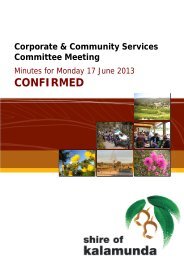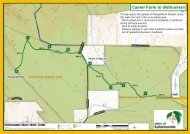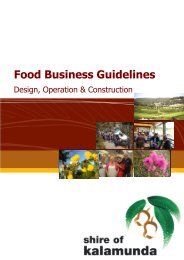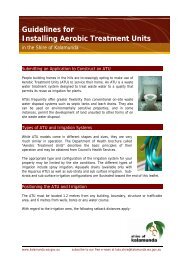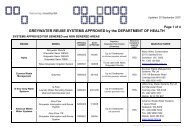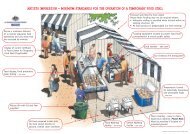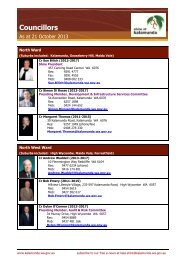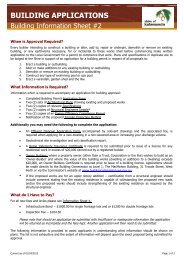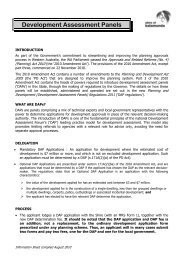Local Biodiversity Strategy: - Shire of Kalamunda
Local Biodiversity Strategy: - Shire of Kalamunda
Local Biodiversity Strategy: - Shire of Kalamunda
You also want an ePaper? Increase the reach of your titles
YUMPU automatically turns print PDFs into web optimized ePapers that Google loves.
option would need to align with the <strong>Local</strong> Planning Scheme and the WAPC's<br />
Development Control Policy 1.3: Strata Titles (<strong>Local</strong> Government <strong>Biodiversity</strong><br />
Planning Guidelines for the Perth Metropolitan Region).<br />
Cluster developments are an extension <strong>of</strong> utilisation <strong>of</strong> Strata Titles for the protection<br />
<strong>of</strong> natural areas. Cluster developments can be used where most <strong>of</strong> the land to be<br />
subdivided consists <strong>of</strong> natural areas. The principle <strong>of</strong> cluster developments is to<br />
cluster buildings and infrastructure in one or two locations. This can be done in two<br />
ways:<br />
i. To make the common property very large and residential lots much smaller<br />
and clustered near each other; and<br />
ii. To have larger individual lots with building envelopes clustered near to each<br />
other.<br />
(Adapted from the <strong>Local</strong> Government <strong>Biodiversity</strong> Planning Guidelines for the Perth<br />
Metropolitan Region)<br />
Cluster developments could be implemented using the Strata Titles Act 1985 or as a<br />
special zone produced through an amendment to the <strong>Local</strong> Planning Scheme No. 3<br />
(refer to Section 11.5).<br />
11.7.4 Rate Rebates<br />
Rate Rebates are one tool used by some Councils, such as the <strong>Shire</strong> <strong>of</strong> Busselton and<br />
the <strong>Shire</strong> <strong>of</strong> Serpentine-Jarrahdale, to recognise the community benefit from<br />
landholders protecting and managing biodiversity on their land. It is one way that<br />
Councils can recognise landholders who make formal longer term commitments.<br />
Before instigating a rate rebate scheme, a feasibility study would be required to<br />
identify the likely cost, the best means <strong>of</strong> meeting this cost that is fair to all <strong>Shire</strong><br />
ratepayers and the most appropriate mechanism for determining the criteria and<br />
operation <strong>of</strong> the scheme, including review provisions.<br />
The requirement for formal commitment to conservation means that the overall take<br />
up would not be onerous. For example, the <strong>Shire</strong> <strong>of</strong> Busselton provides a 50%<br />
rebate for landholders voluntarily entering into a Bushland Protection zoning, but<br />
since 2002, with four properties have entered the scheme with each property having<br />
high conservation values. Likewise, the <strong>Shire</strong> <strong>of</strong> Serpentine Jarrahdale provides rate<br />
reductions for properties that voluntarily seek either Conservation Zoning or<br />
Conservation Living within the Rural Zone. Both Councils apply appropriate criteria<br />
to ensure properties are appropriate for the zoning prior to initiating scheme<br />
amendment.<br />
The value <strong>of</strong> the rebate could be tied to the size <strong>of</strong> the natural area to be protected,<br />
the condition <strong>of</strong> the natural area and/or the management actions implemented by<br />
the landholder. To be eligible for a rate rebate, landholders would be required to<br />
sign a voluntary conservation agreement for a minimum <strong>of</strong> 5 years. Higher rebates<br />
could be made available to landholders entering into conservation covenants in<br />
perpetuity<br />
<strong>Local</strong> <strong>Biodiversity</strong> <strong>Strategy</strong> Page 82



